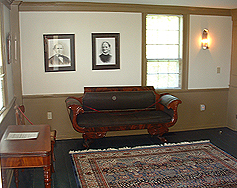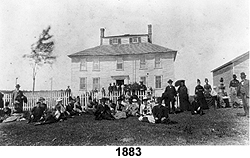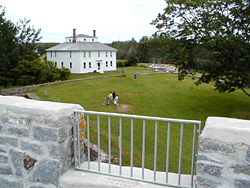DACF Home → Bureaus & Programs → Bureau of Parks and Lands → Discover History & Explore Nature → History & Historic Sites → Colonial Pemaquid → The Fort House
The Fort House at Pemaquid
 This structure, known as the Fort House, has long been a prominent
landmark at Pemaquid. The Fort House's name comes from early
claims that Colonel David Dunbar constructed the building
in 1729, at the same time that he established Fort Frederick
and a settlement at Pemaquid.
This structure, known as the Fort House, has long been a prominent
landmark at Pemaquid. The Fort House's name comes from early
claims that Colonel David Dunbar constructed the building
in 1729, at the same time that he established Fort Frederick
and a settlement at Pemaquid.
In fact, architectural and documentary evidence suggests that Alexander Nickels, Jr., the son of Fort Frederick's last commander, built the Fort House as part of a farm in the last quarter of the 1700s. In 1799, Nickels passed the farm to his son John, who operated it until about 1840. During the next seven years, the Fort House and surrounding farmland were owned first by Samuel Blaisdell then by James Erskine. In 1847, James Partridge purchased the property and successfully raised sheep and crops. The Fort House no longer served as the center of a farm after 1888. By the 1920s, the Partridge heirs were using it as a summer home. They continued to do so until the state of Maine acquired the Fort House in 1976.
 The
Fort House has been significantly modified over the years.
The original structure was a two-story hip-roofed building
with sides two-thirds their current width. Two large brick
chimneys stood near the house's east and west ends. An ell
containing a pantry, wood shed, carriage house, and pig sty
once extended off the Fort House's east (right) side and a
large barn stood nearby. James Partridge carried out a set
of major alterations around 1860 when he moved the chimneys
and added a rooftop monitor.
The
Fort House has been significantly modified over the years.
The original structure was a two-story hip-roofed building
with sides two-thirds their current width. Two large brick
chimneys stood near the house's east and west ends. An ell
containing a pantry, wood shed, carriage house, and pig sty
once extended off the Fort House's east (right) side and a
large barn stood nearby. James Partridge carried out a set
of major alterations around 1860 when he moved the chimneys
and added a rooftop monitor.
 Today, the Fort House is used as an archaeological lab and
storage area. In 1977-78, the Maine Division of Parks and Public Lands
and Maine Historic Preservation Commission funded extensive
repairs to the building's foundation, frame, and exterior.
In 1995, the Friends of Colonial Pemaquid funded a roof replacement
project and, in 1996, re-painted the building. The Friends of Colonial Pemaquid and the Division of Parks and Public Lands continue to improve
the building, with plans to maintain the structure as a lab
and restore the downstairs rooms for special exhibits and
public events.
Today, the Fort House is used as an archaeological lab and
storage area. In 1977-78, the Maine Division of Parks and Public Lands
and Maine Historic Preservation Commission funded extensive
repairs to the building's foundation, frame, and exterior.
In 1995, the Friends of Colonial Pemaquid funded a roof replacement
project and, in 1996, re-painted the building. The Friends of Colonial Pemaquid and the Division of Parks and Public Lands continue to improve
the building, with plans to maintain the structure as a lab
and restore the downstairs rooms for special exhibits and
public events.